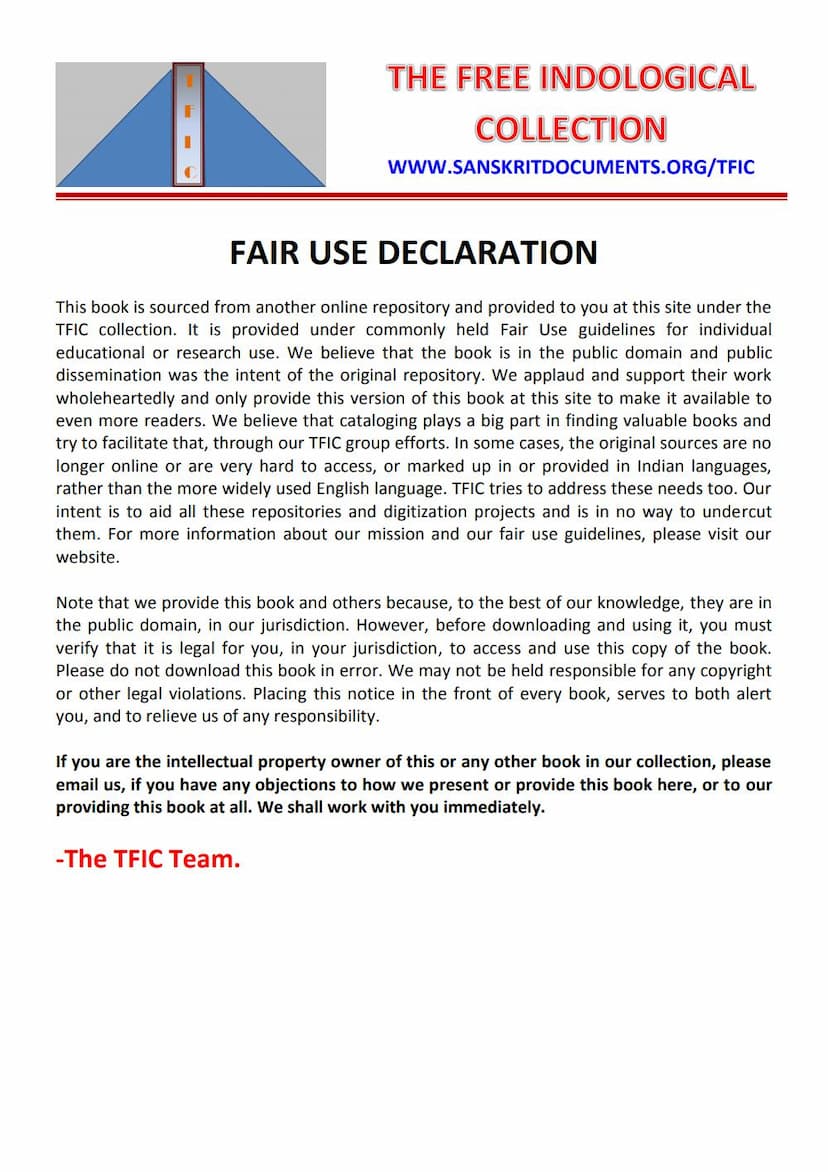Jain Agamo Me Parmatmavada
Added to library: September 1, 2025

Summary
Here's a comprehensive summary of the Jain text "Jain Agamo me Parmatmavada" by Atmaramji Maharaj, based on the provided text:
Overall Theme:
The book "Jain Agamo me Parmatmavada" (Theism in Jain Agamas) by Atmaramji Maharaj critically examines the concept of "Paramatma" (Supreme Soul) within Jainism and contrasts it with the Vedic understanding of "Ishvara" (God). The central argument is that while Jainism posits the existence of a supreme state of spiritual perfection (Paramatma), it fundamentally differs from the Vedic concept of an omnipotent, creator God (Ishvara).
Key Arguments and Points:
-
Distinction between Ishvara (Vedic) and Paramatma (Jain):
- Vedic Ishvara: The text begins by defining the Vedic concept of Ishvara as the creator of the universe, an omnipotent, omnipresent, and eternal being. It highlights the belief that Ishvara controls the world's affairs, dictates destiny, and even takes avatars to establish dharma. The Vedic view emphasizes that humans are incapable and must surrender to Ishvara's will for salvation. It also asserts a fundamental, unbridgeable difference between the devotee and God.
- Jain Paramatma: In contrast, the book asserts that the term "Ishvara" is not used in Jain Agamas to denote the supreme being. Instead, Jainism uses terms like Siddha, Buddha, Ajar, Amar, Sarva-dukha-prahina, Niranjana, Muktatma (liberated soul) to describe the ultimate spiritual state. These terms are considered synonymous, referring to souls that have attained liberation through their own efforts.
-
Nature of the Jain Paramatma (Muktatma):
- Beyond Description: The text emphasizes that the nature of a Muktatma is beyond conventional language, logic, and even the capacity of the intellect to fully grasp.
- Attributes: It describes the Muktatma as formless (arupi), luminous, all-knowing, and all-perceiving. It is devoid of physical attributes such as size, shape, color, smell, taste, touch, and gender. It is free from birth and death, attachment, and the cycle of transmigration.
- Non-Intervention: Crucially, the Jain Paramatma does not interfere in the world's affairs. It is not the creator of the universe, the dispenser of destiny, or the giver of karma-fruits. The concept of avatars is also explicitly rejected.
- Emanating from Self-Effort: Souls attain the state of Paramatma by eradicating their karmas through diligent practice of non-violence, self-control, and austerity, guided by right faith, knowledge, and conduct.
-
The "Ishvara" Term: Historical Evolution and Modern Interpretation:
- The book discusses the historical usage of the term "Ishvara." Initially, in Vedic philosophy, "Ishvara" referred to a powerful cosmic force. However, in later centuries, it evolved to generally represent the Supreme Soul.
- Due to this evolution, many contemporary followers of self-realization philosophies (Atmavada), including some Jains, now use the term "Ishvara" interchangeably with "Paramatma," "God," or "Khuda." This is because, for the general populace, "Ishvara" has become a generic term for the Supreme Being, losing its specific Vedic theological connotations.
-
Three Main Conceptions of Ishvara:
- The book outlines three dominant interpretations of Ishvara prevalent in Indian thought:
- Vedic Interpretation: A single, eternal, omnipresent, omniscient, omnipotent creator God who intervenes in the world through avatars.
- Arya Interpretation: A single, eternal, omnipresent, omniscient God who is the creator but does not intervene in individual karma, and does not take avatars.
- Jain Interpretation: The concept of numerous liberated souls (Paramatmas/Siddhas) who are eternally free, omniscient, and have achieved this state through their own self-effort, without any external divine intervention. The core difference is that Jainism sees the Paramatma not as a singular creator but as the ultimate perfection attainable by all souls.
- The book outlines three dominant interpretations of Ishvara prevalent in Indian thought:
-
The Agamas as the Source of Jain Paramatmavada:
- The book emphasizes that its content is derived from the Jain Agamas, which are considered the authoritative scriptures of Jainism. It highlights the effort made by the author to compile passages from the Agamas that describe the nature of the Paramatma.
- The structure of the book involves presenting original Agama texts, followed by Sanskrit commentary, Sanskrit exegesis, and Hindi translations, making the concept accessible to scholars and general readers alike.
-
Detailed Descriptions from Agamas:
- The text includes extensive quotes and explanations from Jain scriptures like the Acharaanga Sutra, Samavayaanga Sutra, Sthananga Sutra, Bhagavati Sutra, and Uttaradhyayana Sutra. These passages elaborate on the attributes of liberated souls, their location (e.g., Siddhashila), their size and form (or lack thereof), their timeless existence, and the path to liberation.
- It details the 31 virtues of a Siddha, describes the nature of liberated souls being "arupi" (formless) and beyond all sensory and logical description, and discusses their immense happiness, which surpasses that of even the gods.
- The text addresses specific questions about the nature of the soul: whether it grows or diminishes, its permanence, its state of being (e.g., conscious vs. unconscious, embodied vs. disembodied), and its relationship with karma.
-
Anavada (Non-creationism) and Self-Reliance:
- A significant portion of the book reinforces Jainism's rejection of creationism. It argues that souls are the architects of their own destiny, and their liberation or bondage is a result of their own actions, not divine decree. The universe is seen as eternal and without a beginning or end, operating according to its own inherent laws.
-
The Concept of Eternity and Non-Duality:
- The text quotes scriptures that describe the eternal nature of reality, with entities like the world (Loka) and the non-world (Aloka) existing eternally, without a beginning or end. This reinforces the Jain view of an eternal cosmos, independent of a creator God.
- The concept of "Anavada" (non-creationism) is presented as a core tenet, differentiating Jainism from other theistic traditions.
In essence, "Jain Agamo me Parmatmavada" aims to clarify and defend the Jain perspective on the supreme spiritual state, emphasizing self-effort, liberation from karma, and the ultimate perfection of the soul, distinct from the external, creator-God paradigm found in Vedic and other theistic traditions.